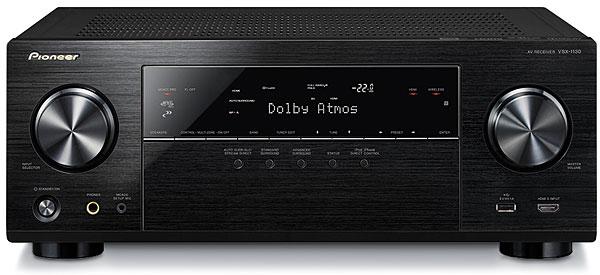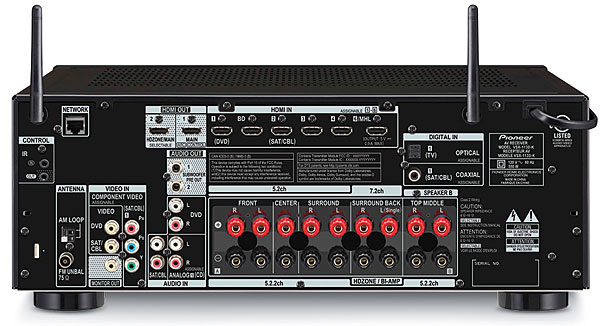Pioneer VSX-1130 A/V Receiver Review

AT A GLANCE
Plus
Dolby Atmos 5.2.2
Wi-Fi, AirPlay, Bluetooth on board
HDCP 2.2 rights management
Minus
Tight, crowded remote control
THE VERDICT
With Atmos added and both Wi-Fi and Bluetooth newly baked in, this receiver is a better value than its immediate $600 predecessor.
Less than a year has passed since I called the Pioneer VSX-1124 both “a top-performing receiver at a competitive price point” and, just in case that seemed too dispassionate, “a miracle.” So much has happened since then. For starters, Dolby Atmos happened, adding object-oriented surround with dedicated height channels to the basic surround footprint. Yet it’s almost a shock to see Atmos in a $600 receiver, the new VSX-1130. If you’re still on the fence about Atmos, Pioneer hasn’t stopped there. Bluetooth, formerly a $99 accessory, is now baked in. And what’s that thing sticking up in the back? Oh, that’s the Wi-Fi antenna, formerly a $129 accessory. Those two changes essentially add $228 of value to Pioneer’s $600 receiver, and together with Apple’s AirPlay, they make it what I like to call a wireless triple threat.
The New Receiver King
Onkyo’s and Pioneer’s A/V businesses have merged to form Onkyo and Pioneer Corporation
in Japan. The original Pioneer Corporation is still in the car audio market, but the new Pioneer/Onkyo entity handles the brand’s A/V receivers and bills itself as the world’s largest receiver manufacturer.
Pioneer’s receivers continue to be split between the regular Pioneer line and the Pioneer Elite, with each getting two new models. The 7.2-channel VSX-1130 falls on the regular Pioneer side along with the 5.2-channel VSX-830 ($400). The extra two channels in the VSX-1130 are what enable it to be Atmos-capable; these can be allocated to a pair of Atmos height channels. Along with the dual subwoofer channels, that makes it a 5.2.2 model in Atmos-speak. Two more channels would be needed for 5.2.4, which would provide for better Atmos elevation effects throughout the room. Should we call 5.2.2 “Atmos Lite”?
Along with Atmos and the wireless triple threat, this receiver adds HDCP 2.2 compliance to its HDMI ports, which Pioneer specifies as “Full Bandwidth HDMI (4K Ultra HD 60p/4:4:4),” though without the HDMI 2.0 designation. That means it can do the copyright handshake with future copy-protected UHD signal sources. HDCP 2.2 was largely absent from last year’s 2014 AVR models, and even some TVs, so it’s good to see that changing.

With an iPhone- and iPod-compliant (but regrettably, not PC-capable) USB jack on the front and an MHL-enabled HDMI input on the back, this receiver is compatible with a variety of smartphones and tablets. HTC Connect allows HTC One smartphones to share music files with the receiver. On the audio streaming side, the Pioneer offers integrated Spotify, Pandora, and vTuner. I’ve yet to see a receiver that offers the trendier Apple Music (just announced at press time) and the audiophile-approved lossless Tidal (under new, higher-profile ownership). The only thing noticeable subtracted from last year’s feature set is Roku Ready certification, which supported the MHL-based Roku Streaming Stick. Since there is still an MHL-enabled input, and because Roku now offers a version of its Stick that works with any HDMI input, this may be inconsequential; I was unable to verify.
Boot up the graphic user interface, and you’ll see changes. While Pioneer hasn’t altered the GUI’s familiar font or spartan color scheme, it has reorganized the home screen into just three items: Network/Bluetooth, MCACC Pro (for auto setup and room correction), and System Setup (for manual settings). In addition to offering a simpler entry point than its cluttered predecessor, this new GUI pays tribute to the increasing importance of network and wireless features, a neat counterpart to the integrated Wi-Fi, AirPlay, and Bluetooth.
The iControlAV5 app, now in its fifth generation, is the best I’ve seen in a receiver. Good thing, because the crowded remote, while functional, has an unfriendly multitude of tiny buttons. The home network connection can be set up with an iOS or Android device already connected to the network—neat, eh? AVNavigator, a Web-browser control option that formerly required installation on a PC, is now built in. This model’s version of AVNavigator also has an Interactive Operation Guide that explains features when you click on reproductions of remote buttons. Although it runs on Windows PCs (Vista and later) and Macs (OSX 10.8 and later), it also worked well on my iPad. The guide is available only for the VSX-1130 (not the VSX-830).
The Pro version of MCACC—the Multi-Channel Acoustic Calibration System, Pioneer’s proprietary version of auto setup and room correction—has been updated to handle Dolby Atmos. It supports four-band subwoofer EQ for two subs, applying the same settings to each sub. The VSX-1130 marks the first time the Pro version has been available in a $600 receiver; last year, it was limited to models costing $1,600 and above.






























































